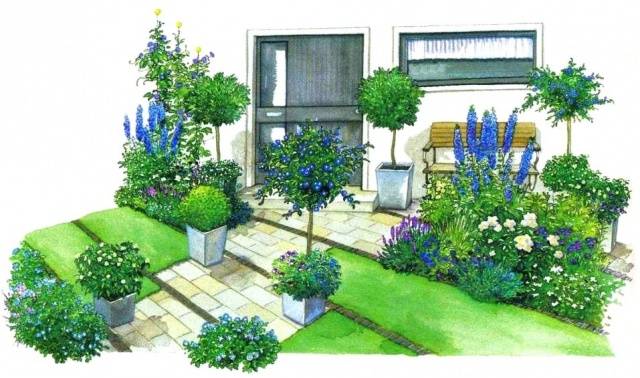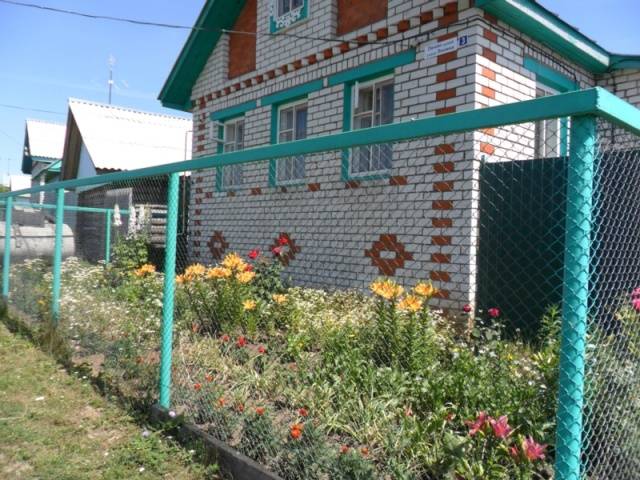Content
If you live in a private house, then you have the opportunity to fully realize your creative potential. Mainly it can be reflected in the care and arrangement of the local area. So, many people decide to make a front garden with their own hands. At first glance, it may seem that everything is simple here. However, if you want it to please you all year round, then it is important to think through everything to the smallest detail. Today there are many options for its design, and some even turn to designers, but after carefully researching this material, as well as looking at the photos and videos in this article, you will be able to do everything yourself. Your front garden will be a real decoration for your home.
Advantages and disadvantages
It is important to understand that the front part of the house is the most visible and is what people pay attention to first. For this reason, the design of the front garden is carried out with special care. If we talk about the advantages in favor of the front garden, then this is an excellent landscape design. The adjacent area, that is, the front garden, will have an excellent decorative function.In some cases, the front garden can even hide some of the shortcomings of the house, and if there are advantageous aspects, then, on the contrary, emphasize it. In general, a beautifully landscaped area near the house will be pleasing not only to your eyes, but also to everyone around you.
However, the front garden in front of the house also has disadvantages. First of all, it takes a lot of time to care for it. After all, growing plants or flowers may need to be trimmed, watered, fertilized, or other types of care on time. It also takes time to clear the area of fallen leaves. It is necessary to loosen the soil in time so that the flowers/plants do not become stunted. As you can see, a do-it-yourself front garden has the main disadvantage - a considerable amount of maintenance time.
Types of front gardens and design
All front gardens are divided into two types of fencing:
- Open front gardens.
- Enclosed front gardens.
In the first case, the beauty of the front garden in front of the house can be observed both from the street and from the side of the house. If it is closed, then this element of landscape design will definitely have a fence. Among other things, the design of the front garden in front of the house also differs. Now we will briefly list the most common ones.
European
In this case, the front garden in front of the house will have clear geometric lines, in which rigor and consistency of proportions will be observed. A free approach to design is not encouraged here. Mainly in this style the presence of a massive hedge is excluded.
Russian
This type of front garden in front of the house must have a fencing structure. There are no requirements to adhere to the strictness of all lines. The main requirement of a front garden is a beautiful design that will please the eye.
Oriental
With this design design, decors, stones, and conifers will be used. In this case, the plants are predominantly dwarf.
Mediterranean
Here it is necessary to use a large number of blooming flowers and trees growing in small containers. You can install all kinds of sculptures, lanterns and other decor. There must be a bench, a table and a small canopy for shelter from the sun and rain.
Rustic
This style partially overlaps with French. Just like the French style, rustic emphasizes the natural features of the landscape. The rustic style uses all kinds of decorations, for example, a cart, a broken clay jug, etc.
Romantic
If you are a romantic at heart, then you can decorate your front garden in this style. There are all kinds of arches here, and flowers/plants should entwine all the fences. At the same time, the flowers should be long-blooming and beautiful.
French
French style, also known as Provence. This style of decorating the front garden in front of the house combines lightness, beauty, freedom and love. The French style will allow you to enjoy beautiful plants/flowers and the decoration of your local area every day.
This is a brief description of some front garden styles. On the Internet you can find many other ideas on how best to decorate the local area near your private home.
Design development
So, now let's get down to the actual design and planning, remember, our main goal is to create a beautiful front garden in front of the house. Therefore, it is necessary to think about what flowers will be planted. Do you want them to bloom continuously until frost? What type of flower bed is best to organize?There are several varieties of it:
- Mixborder. Complex composition of various and flowering plants. This includes planting decorative flowers. Although this composition is complex, it is very popular.
- Border. This means a path leading through a small area of a flowering flower bed to the house and landscaped with a border.
- Alpine slide. In this case, a kind of imitation of a mountain landscape is created. Here you will need stones and all kinds of ornamental plants and flowers.
- Rabatka. If the front garden in front of the house has the shape of a rectangle, then all the flowers/plants can be planted in even rows.
Choice of colors
Having decided how to decorate the front garden in front of the house, it is necessary to solve another question - what flowers to choose for the front garden in front of the house. Perennial plants and flowers are usually preferred. Ornamental trees and shrubs are often used. Such shrubs may include:
- Common juniper.
- Boxwood is evergreen.
- Common barberry.
- Thunberg, etc.
As for the choice of trees, most often these are standard ones, which allow organizing the arrangement of flower arrangements near the trunk. This category includes the standard western thuja or Norway maple.
As for flowers, this is perhaps an endless topic. There are many varieties of flowers, so we will only give you a general direction. If you want the front garden in front of your house to please you all year round, then preference is given to perennial flowers that bloom until the first frost.Among the perennials you can remember violas, forget-me-nots and primroses. In mid-spring, in May, blooming daffodils would look good. In the first two months of summer (June/July), tiger lilies, peonies, irises, Turkish carnations, marigolds, petunia, nasturtium, chrysanthemums, and phlox bloom. At the end of summer, chrysanthemums and asters can also please the eyes.
This is a small guide on how you can decorate your front garden with your own hands. Additionally, it is worth highlighting several important features when choosing ornamental plants and flowers:
| Peculiarity | Description |
|---|---|
| Landing location | For some flowers, the sunny side or, conversely, the shade is important. Therefore, this should be taken into account when choosing a suitable location in the front garden in front of the house. For example, if your local area is predominantly located on the sunny side, then an excellent solution would be to plant gladioli, phlox, lupina, aster, petunia, peonies, and daisies. If the area is shaded, then give preference to ferns, hostas, and forget-me-nots. |
| Flowering period | In this matter it is also worth calculating everything correctly. Otherwise, all the flowers will bloom in one month and that’s it. All flowers are divided into several categories, for example, early blooming: primroses, daisies, lilies of the valley, tulips, daffodils, hyacinths, crocuses. Medium flowering: cosmos, nasturtiums, marigolds, bells, phlox, daylilies, irises, peonies. Late bloomers: chrysanthemums, asters, dahlias. |
| Height of plants/flowers | In this category, flowers are also divided into species. Tall: canna, lupine, gladiolus, foxglove, delphinium. Medium-sized: rudbeckia, bellflower, salvia, poppy, chamomile. Low-growing: nasturtium, pansy, purslane, scabiosis.Taking this into account, you can combine the growth and color of all plants and flowers. In this case, you will get a wonderful composition. |
| Life period | There are three categories of flowers based on their lifespan: annual, biennial and perennial. Annuals: Snapdragon, asters, cosmos, marigolds, petunias. Biennials: pansies, daisies, foxgloves, Turkish carnations. Perennials: rudbeckia, iris, daylily, lupine, chamomile, callas, gladioli, dahlias. |
If you do not yet have experience in caring for your front garden, then give preference to unpretentious plants and flowers. In this case, you will simultaneously gain experience and will not waste a lot of time.
You may wish to plant ornamental shrubs. There is a wide variety of them and they can really add bright colors to the local area. For example, rosehip, buddleia, hawthorn. You might want to build an arch, then climbing plants/flowers would be great. They can protect your windows and home from dust. For example, these could be climbing roses, wisteria, honeysuckle, campsis, etc.
Coniferous plants will look no less original. And given that they are evergreen, they will smooth out the gloomy autumn days throughout the year. Thus, winter plants include juniper, yew, boxwood, thuja, and dwarf spruce.
Around this design with flowers, a slide with a waterfall or other decorative elements will look beautiful. Even if you don’t manage to think through everything down to the smallest detail, you can always change something along the way.
Conclusion
So, we have looked at all the features of how to make a front garden in front of the house. As you can see, there are no strict and specific rules. Everything is taken into account solely from tastes and preferences. We hope that this material has provided you with food for thought, and in addition we offer you to watch an interesting video:

















